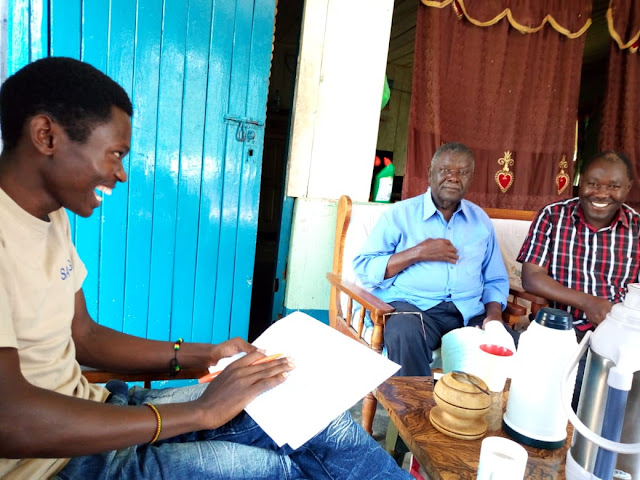The Ahai
 |
| With Adamba and his son at Manyinya village near Majengo |
In one of the organized documented genealogies, the Ahai's could be closer to providing Saniaga Oral Genealogy excercise with a blue print in structuring the rest of the Saniaga Family trees if only some more more flesh is added to the tale.
Saniaga is said to have begotten Asacha, Kavonji, Nyanza, Andago and Mweremi sons. I date Nyanza as born 1718 and Saniaga assumably late 1600's. Or whatever a people that adopted Saniaga as an identity in that century.
Of the four sons, we are going to highlight Nyanza as of today's Saniaga Oral Genealogy Search and Documentation. Therefore Nyanza begot Livanze, Kwaga, Muderema and Odiri. We shall again take Livanze, leaving the other tree for our continuing Search.
Livanze begot Anga (in other documentation he begot Ahai. Confusing me. Eitherway one is the father and the other a son). One documentation says that Livanze begot Ahai and Ngana. Another says he begot Anga, Ambula and Isanza.
Where Anga is the son of Ahai, the tale says Ahai begot Anga, Ayoyi, Abudava and Lisasa. And where Ahai is the son of Anga, the tale says Anga begot Ahai, Akemola and Namambwa.
All understood so (and agreed worth a Search too), the people of Anga are Endegure, Anidele and Mbaragani. Of Ayoyi are Ogoli, Javaya, Endondo and Imbwana of a first woman and Obindi and Kendi of another woman. The last two are found at Kidundu. Abudava begot Asega of Kidundu, Kemeni, Kavai, Chavariga and Mugunda who went to Mazigulu. Lisasa had Mbali, Ongoya, Muhandare, Kebe and Ijusa.
From there I take Imbwana and Endegure to inform you better today. Imbwana of Ayoyi and Endegure of Anga.
Imbwana begot Japheth Imbugi who then begot Nathan Imbugi Luvai in 1919 and six others. Arthur Imbwana Luvai is the grandchild of Japheth. On Endegure's side, he begot Odondi who begot Samuel Adamba and Andrea Keya, two sons. There was Rhoda and Nora as their sisters. In 1939, George Adamba was born as the first son of Samuel. He is known for his pastoral work with the PAG church.
There is flesh to the above, with places of settlements and reasons why. For example, Odondi Endegure had land at Chango. And another at iMang'ang'a in Majengo. Samuel Adamba was to inherit. But it was sold to Imbugi, a neighbour Saniaga. Same as George Adamba says that the land he bought just beside his ancestral's at iMang'ang'a village was of one Saniaga called Kayere who had two wives, the younger house there. They shifted and he cannot tell their whereabouts.
Saniaga is said to have begotten Asacha, Kavonji, Nyanza, Andago and Mweremi sons. I date Nyanza as born 1718 and Saniaga assumably late 1600's. Or whatever a people that adopted Saniaga as an identity in that century.
Of the four sons, we are going to highlight Nyanza as of today's Saniaga Oral Genealogy Search and Documentation. Therefore Nyanza begot Livanze, Kwaga, Muderema and Odiri. We shall again take Livanze, leaving the other tree for our continuing Search.
Livanze begot Anga (in other documentation he begot Ahai. Confusing me. Eitherway one is the father and the other a son). One documentation says that Livanze begot Ahai and Ngana. Another says he begot Anga, Ambula and Isanza.
Where Anga is the son of Ahai, the tale says Ahai begot Anga, Ayoyi, Abudava and Lisasa. And where Ahai is the son of Anga, the tale says Anga begot Ahai, Akemola and Namambwa.
All understood so (and agreed worth a Search too), the people of Anga are Endegure, Anidele and Mbaragani. Of Ayoyi are Ogoli, Javaya, Endondo and Imbwana of a first woman and Obindi and Kendi of another woman. The last two are found at Kidundu. Abudava begot Asega of Kidundu, Kemeni, Kavai, Chavariga and Mugunda who went to Mazigulu. Lisasa had Mbali, Ongoya, Muhandare, Kebe and Ijusa.
From there I take Imbwana and Endegure to inform you better today. Imbwana of Ayoyi and Endegure of Anga.
Imbwana begot Japheth Imbugi who then begot Nathan Imbugi Luvai in 1919 and six others. Arthur Imbwana Luvai is the grandchild of Japheth. On Endegure's side, he begot Odondi who begot Samuel Adamba and Andrea Keya, two sons. There was Rhoda and Nora as their sisters. In 1939, George Adamba was born as the first son of Samuel. He is known for his pastoral work with the PAG church.
There is flesh to the above, with places of settlements and reasons why. For example, Odondi Endegure had land at Chango. And another at iMang'ang'a in Majengo. Samuel Adamba was to inherit. But it was sold to Imbugi, a neighbour Saniaga. Same as George Adamba says that the land he bought just beside his ancestral's at iMang'ang'a village was of one Saniaga called Kayere who had two wives, the younger house there. They shifted and he cannot tell their whereabouts.
Comments
Post a Comment